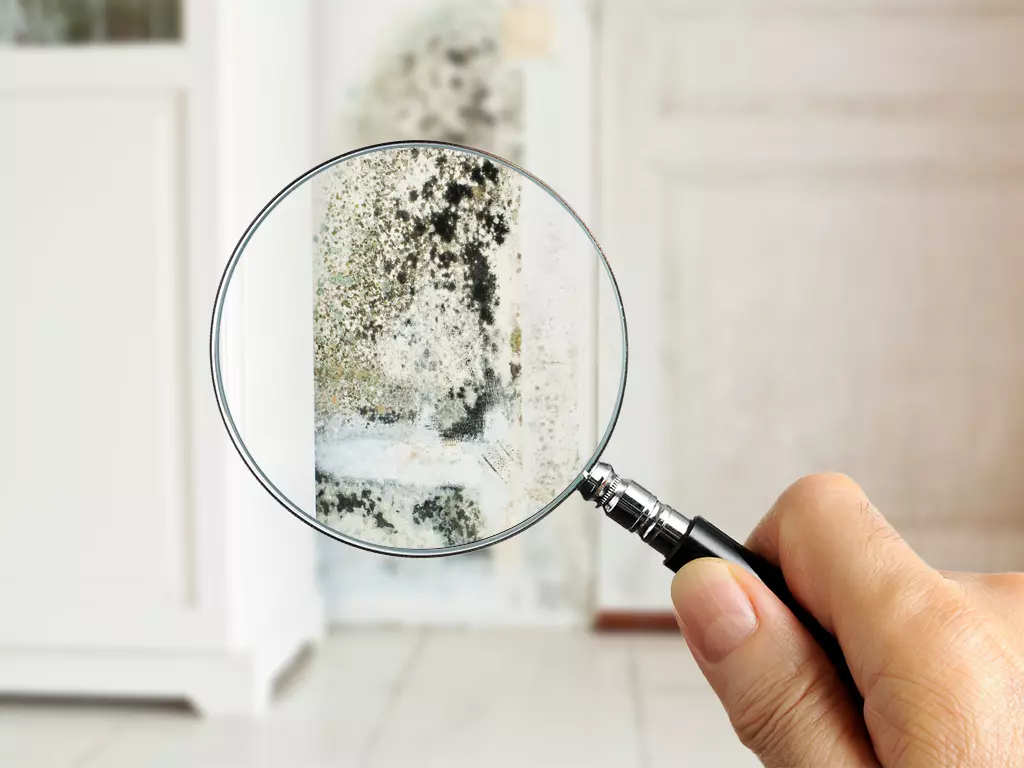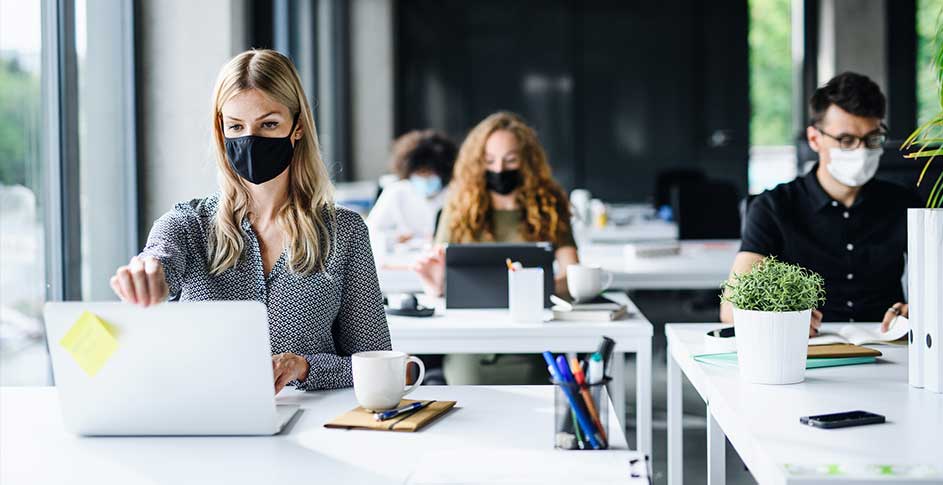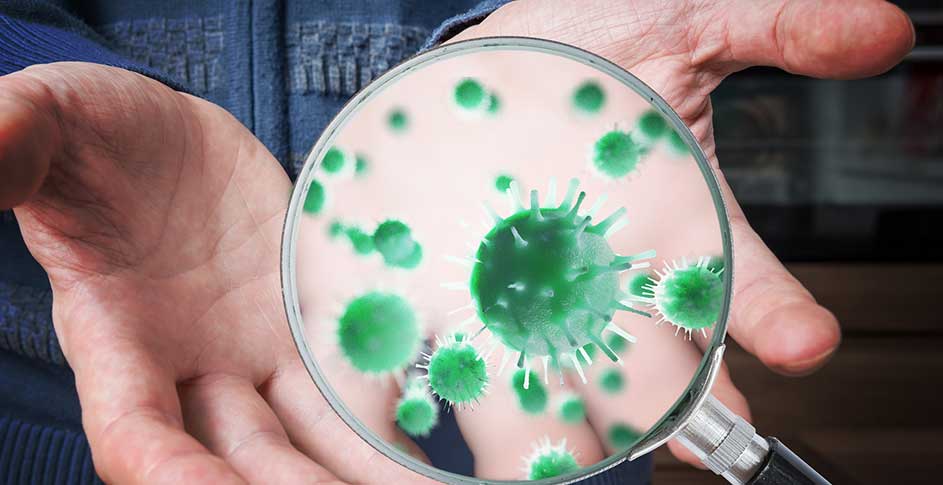Humans inhale 1 to 10 mold spores with every single breath. According to the CDC, “there is a little mold everywhere — in the air and on many surfaces.” It’s important for organizations to know how mold can affect their air quality and their employees. Below are 7 questions and answers about indoor mold.
What is Mold?
Molds include “all species of microscopic fungi that grow in the form of multicellular filaments, called hyphae,” per the EPA. Therefore, what makes something a mold is not the species of fungi, but rather the type of structure that a given fungi forms.
What is the Difference Between Mold & Mildew?
Unlike “mold,” the term “mildew” doesn’t have a standardized definition. The term often refers to a white fungal growth found on dead or living plants, as opposed to green mold growing in the shower. According to the EPA, however, mildew more broadly refers to any mold with a “flat growth habit.” This definition makes mildew a subtype of mold. It isn’t necessary to identify whether a particular mold also classifies as mildew; both are undesirable indoors and treated similarly.
How Does Mold Affect Air Quality?
Molds reproduce by releasing spores — reproductive cells capable of becoming new fungal colonies. Many mold spores are too small to be seen by the human eye. According to a 2009 German study, “On average, there are between 1,000 and 10,000 fungal spores in every cubic meter of air.” However, this number can increase substantially under the right conditions.
The main effect of this on air quality is an increase in allergy and asthma triggers. According to the CDC:
Molds can trigger asthma symptoms including shortness of breath, wheezing, or cough in people with known allergies. People who do not have allergies can also become irritated. Studies indicate that exposure to molds in the workplace can make pre-existing asthma worse.
Mold colonies can also release microbial volatile organic compounds (mVOCs) into the air. The effects of these are not as thoroughly studied as non-microbial VOCs, but there is some suggestion that they may cause headaches, respiratory irritation, fatigue, or nausea.
Can Mold Make You Sick?
Generally, airborne mold spores are not life-threatening, even if they are annoying. However, they still have the potential to make people sick:
- Asthma: As mentioned above, mold can be an allergy and asthma trigger. Severe asthma attacks can be deadly, but such deaths are not very common.
- Hypersensitivity: People can sometimes experience an immune reaction to mold exposure beyond normal allergies. This results in a condition called hypersensitivity pneumonitis (HP). HP appears similar to pneumonia but does not resolve with antibiotics. Untreated HP may cause permanent lung damage.
- Infection: Occasionally, certain species of mold can colonize the lungs of immunocompromised humans via air. One such infection, invasive aspergillosis, has a fatality rate of up to 90%. However, most people inhale Aspergillus spores daily without contracting the infection. On average, around 0.002% of people acquire invasive aspergillosis.
- Mycotoxins: Some molds produce toxins that can be harmful or deadly to humans. The effects of these mycotoxins range from organ damage to cancer. However, this generally occurs when harmful molds contaminate food.
What Causes Mold Growth Indoors?
One word — water. Mold spores that land in a place with moisture start blossoming into colonies. And since mold spores are ever-present, this means that any source of water can cultivate mold growth. Slight condensation on the HVAC duct, dampness trapped between the walls after a flood, a leaking pipe under the break room sink — all of these are perfect situations for mold growth. Weather-related disasters — such as flooding and hurricanes — can also result in excessive mold growth.
 Controlling moisture is the single most important thing you can do to prevent mold colonies from thriving indoors.
Controlling moisture is the single most important thing you can do to prevent mold colonies from thriving indoors.
Like all living organisms, mold colonies need a source of food. But as mold can digest nearly anything — from dust to ceiling tiles to paint — this is not a limiting factor.
Can Mold Impact the Bottom Line?
Regardless of the cause, poor air quality will affect the bottom line.
If your mold problem is evident, it will certainly impact finances. If you let your mold situation spiral out of control, your building may even require professional remediation or major renovations — costing your business more than it would have to face the issue head on.
Less apparent problems can also lead to a financial headache for your organization. As spores spread out from a hidden mold colony, decreased productivity may result from allergic reactions, asthma attacks, and fungal infections.
How Do I Reduce Mold Exposure Indoors?
It is important to understand that no indoor space is completely free from mold spores – not even a surgical operating room. Mold is everywhere, making our exposure to molds unavoidable, whether indoors or outdoors, at home or work.
The goal should be to reduce mold exposure, not eliminate it. There are 3 components of reducing mold exposure indoors: moisture control, spot cleaning, and active air purification.
- Controlling Moisture: This is the single most important thing you can do to prevent mold colonies from thriving indoors. Moisture control is a multi-faceted task that includes controlling humidity levels; promptly fixing leaks; making sure an area is fully dry before commencing repairs; and properly ventilating shower, laundry, and cooking areas.
- Spot Cleaning: Spot cleaning can reduce mold colonies and their food sources. This tool includes vacuuming with a HEPA filter that traps the spores and reduces dust, which mold relies on for growth. While you might be inclined to use bleach to kill your mold; however, bleach isn’t able to penetrate porous surfaces and can even be a food source for mold colonies. Use vinegar, because its acidity kills mold at the roots.
- Active Air Purification: Active air purification can supplement your moisture control and spot-cleaning efforts by reducing the number of mold spores indoors. Passive purification (such as HEPA filters) can trap spores, but this does not prevent the spores from growing on the filters themselves. ActivePure’s technology, however, strips the mold spore’s protective coating, preventing it from blooming. In fact, devices with ActivePure Technology have been tested on at least 5 different fungal spores, and have successfully neutralized up to 99.9% of them in minutes.
Check out our other blogs to learn about types of molds and how they might affect your organization.



